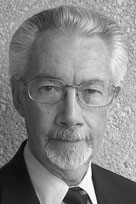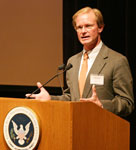| REVIEW
By David G. Woodcock,
FAIA, FSA, FAPT
Professor of Architecture
Director, Center for Heritage Conservation
College of Architecture, Texas A&M University
Editor’s note: The 2006 Rowlett Lecture, "Beck: Tearing
Down the Silos,” focused on the Beck Group, a 93-year-old
architecture, construction and real estate firm headquartered
in Dallas. The following review, penned for Texas Architect magazine
by David Woodcock, is reprinted here with permission.
On 3 February 2006 the CRS Center in the College of Architecture
hosted the 2006 John Miles Rowlett generously endowed by the
founders of CRS and Mrs. Virginia Rowlett in 1979. Once again,
the afternoon event explored the inner workings of a major firm
in the design and construction industry. The focus was on BECK,
known to many as the general contractors on such outstanding
projects as the highly-acclaimed Nasher Sculpture Gallery in
Dallas, but gaining much attention on their dramatic transition
to an integrated approach to “better buildings, better
built, “ as their business card proclaims.
Managing Director and CEO Peter Beck’s philosophy is contained
in his article published in Design Intelligence, 9 November last
year. His article “Collaboration or Integration: Implications
of a Knowledge-Based Future for the AEC Industry,” described
the drawbacks to traditional design/bid/build project delivery,
and suggested the use of computer-driven tools (many already
existing in separate application modes) to allow a greater and
more effective rate of knowledge exchange between all members
of the design and construction team, to avoid wasted effort,
and therefore high costs, in the creation and delivery of buildings.
The article notes that major clients, like the General Services
Administration in the U.S. and the British Airport Authority,
are demanding a Building Information Model (BIM) as the common
platform for all participants in the process.
The Beck Group, already a major player in the world of real
estate, construction and technology, entered a new, and daring
phase, when it merged with the well-respected, and design-oriented
firm, Urban Architecture, in 1991. Rick del Monte, AIA, became
a Managing Director of the newly integrated firm, described the
integration process as challenging. Betsy del Monte, AIA, a Principal
in the firm noted that their first project was a crash-deadline
project to create new offices, using a process that gave equal
status and equal value to the architects, engineers, estimators,
and project managers. Modeling techniques that provided instant
cost data allowed the design alternatives to be explored rapidly,
and components, assemblies, systems and finishes to be proposed,
priced, and coordinated, allowed the project to be delivered
on time, though Ms. Del Monte also agreed that the process was
challenging!
The discussion on case studies combined the perspectives of
architects and project managers responsible for multi-million
dollar projects. The SBC Headquarters had the added complication
that the client did not want to own the building, putting Beck
in the position of being owner but not user, and having to work
backwards from the financial pro-forma and the client’s
fixed expectations on the cost of the lease. The integrated approach,
including Beck’s familiarity with the economics of development,
allowed the firm to produce an exemplary piece of architecture,
on the accelerated timescale demanded by the client, and meeting
the exacting financial specification that allowed Beck to make
a long-time success of the project. Like many of Beck’s
major clients, SBC was also keenly interested in operating costs,
and the new headquarters also met stringent LEED standards. Case
studies for a major shopping center and a large church complex
also demonstrated the unique opportunities for savings afforded
by integrating the experience of seasoned professionals across
the design/build disciplines. They also demonstrated the need
for willing clients as well as a talented professional team!
The afternoon concluded with a demonstration of the software
package that drives the Beck Group’s decision-making process
from site selection to building management, described by Peter
Beck as “technologies (that) radically improve current
processes by integrating knowledge through encoded rules and
algorithms.” The demonstration was made by Stewart Carroll,
Director of Beck Technology, who admitted at the outset that,
prior joining the firm, he had never seen a set of drawings for
a building, never read a specification, and never been in a job
shack! As Carroll provided site information, restrictions on
building area, variations on plan and structure, interior configurations,
and alternate materials for the building envelope on his laptop,
the software provided instant data on their impact on building
costs, efficiency, and other information that could guide decision-making
by the team. Asked about the reliability of the cost data, it
became clear that, like all good companies, Beck gains its information
the hard way, they work at it! The Director of Pre-construction
Services leads an experienced group of cost estimators, who maintain
an effective finger on the pulse of construction and material
costs.
In looking to the future Peter Beck made it clear that the integrated
approach was “a work in progress.” The concept of
integrating selected sub-contractors, whose work could be part
of the initial design decisions seems attractive, but might call
into question basic issues of open opportunities for trade. Nevertheless,
the Beck Group’s attempt to develop a design and delivery
process that relies on open communication and a single company
provided much food for thought.
Inevitably, the academic setting raised a question about the
education that would best prepare those who would enter a newly
integrated field. Wisely, the Beck panelists spoke only generally
about the need for individuals who were creative, open-minded,
and who were skilled communicators.
Perhaps the only caveat about Rowlett 2006 would be the title
of the event. Far from “tearing down the silos” the
Beck Group relies on its staff to be some of the brightest, and
most skilled and experienced in their fields. What is being ‘torn
down’ is not the silo itself, but limited and constrained
communication, based on ‘traditional’ models of business
practice. It is being replaced with a real-time synergy within
the process of designing and building. Bill Caudill, one of the
founders of CRS, never faltered in his belief that the team relied
on the individual strength of the players.
As with many exposures to the world of practice, academics must
be sure to draw the right lesson. Success is based on in-depth
understanding of one’s own field, and a willingness to
respect those with whom you interact, and whose own preparation
and experience comes from other fields. In a college like that
at Texas A&M University, the advent of our second century
must recognize that the strength of a team member derives from
professional awareness, understanding and ability. Strong academic
departments and curricula are essential to preparing future leaders.
The ability to communicate and create begins with the discipline,
and requires thoughtful and intense learning. Once the aspiring
professional has acquired sufficient knowledge and confidence
then, and only then, is it possible to begin developing opportunities
for integrating educational experiences between disciplines.
The Beck Group and senior students in Architecture and Construction
Science successfully undertook such an integrative process in
a fall 2005 design studio. Education for future practice is not
a mirror image of practice itself. The Rowlett Lecture Series
is indebted to the Beck Group for sharing their experiment, an
experiment that reinforces the value of disciplinary strength,
experience and judgment as the basis for any future practice
mode.
• David G. Woodcock, FAIA, is professor of architecture
at Texas A&M University and a Contributing Editor of Texas
Architect.
| |

David Woodcock

Peter Beck delivers the 2006 Distinguished Firm
Lecture

Peter Beck meets a student from the college
of architecture
|

